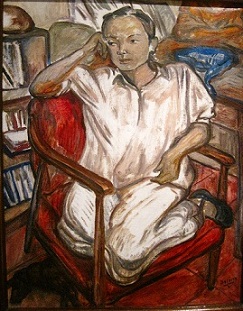Text and photos by ELIZABETH LOLARGA
“GIFTED” is an understatement in describing the scope of Joy T. Dayrit’s works. She was a writer of short stories and poetry, a painter, a children’s art teacher and friend to many writers and artists. She was an admirable woman for whom a disability was no cause for diminishing her zest for life.
The Ateneo Library of Women’s Writings (ALIWW) and the Ateneo de Manila University Press launched Light, her selected stories, in a slim, elegantly designed book in a color brighter than celadon green.
Edna Zapanta Manlapaz, book editor and ALIWW founder, remembered Josephine Teodoro Dayrit, who used the professional name “Joy T. Dayrit,” as a meticulous writer who would submit to the former’s class several drafts of the same work in graduate school. Manlapaz would be stumped to look what was outstandingly new about it. She’d read the latest draft line by line until she discovered that an adjective was deleted, and that discovery would make Dayrit smile.
This meticulousness informed even her art. A fine example is the series “My Chair/30 Times” wherein she painted 30 versions of her chair and cane as subject. Somehow, it reminded one of Wallace Stevens’s famous poem “Thirteen Ways of Looking at a Blackbird.”
As Manlapaz said, it was quintessentially Dayrit to do repetitions with variations (the hallmark of a distinct style), perhaps with an eye to perfection. It also proves that anything can feed the imagination of a disciplined writer and painter which Dayrit was.
Quite telling in her story “A Quiet Infidelity” is how a persevering priest and a successful accountant, once childhood sweetheart, tame their ardor with just a chaste kiss exchanged between them.
In “Roda,” the title character chides friend Greg for working hard to make a name for himself in a business office, for always being hurried and not setting aside time to relax and to enjoy his friends’ company. This story serves as postlude to an earlier one where Roda’s life is cut short by a sudden illness and Greg appears as one of the mourners.
There are no highly dramatic, emotionally draining and tear-jerking scenes. Dayrit’s prose is clean and spare that one is almost tempted to call it “Hemingwayesque”. But that would make her turn in her grave for in one of her journals, she bristled at a comment made by National Artist Nick Joaquin who during a meeting with women writers, said aloud how they could write if they were pregnant or busy raising small children.
This is where ALIWW’s mission comes in, restoring Dayrit, who passed away last year, to her place in the literary canon. After all, she won literary prizes from the Palanca Memorial Awards and Focus Philippines literary contest apart from her stories passing the astute editorial eye of Joaquin himself and getting published in the pre-martial law Philippines Free Press.
At the ALIWW exhibit that pays tribute to the writer-painter, the space is made out like Dayrit’s private office and library. On the walls are paintings large and small, especially selected by her dear friend Roberto Chabet, the esteemed father of Philippine contemporary art. The look of her desk is recreated with a word bank (a wooden box) near her electric typewriter which, one assumes, she utilized to get what’s known as ‘writing prompts” to get her started.
Her eyeglasses are there, as though she had just taken them off to stand up, stretch, step out to take a snack or go to the toilet, leaving a sheet of newsprint paper fed in the typewriter with a playful reflection on having a dual-colored typewriter ribbon. It reads: “My new typewriter ribbon is black and red. I had wanted only black, but that was out of stock. So black and red it is. If you go with the flow, it could be fun.”
This fun-loving side of her is reflected in the colorful mobiles hanging from the inside of an open antique closet. These heart-shaped mobiles painted back to back were meant for her grand-nephews and grand-nieces to play with.
Underneath the glass-topped tables are photos of Dayrit from childhood to adulthood. In almost all of them is her bright, brave smile, even as she was being fitted with leg braces. Manlapaz quoted the late Kerima Polotan who once told sculptor Julie Lluch, “When Joy enters a room, she lights it up.”
In her journals, Dayrit wondered what her true calling was: writer or painter? One day, she quit agonizing when she realized that she was happy being both, that she did not need to fragment herself, that words and images were what defined her.
The ALIWW exhibit, which runs till Aug. 31, has been visited by droves of freshmen since the schoolyear started. It bodes well. Dayrit’s writings and art are alive.